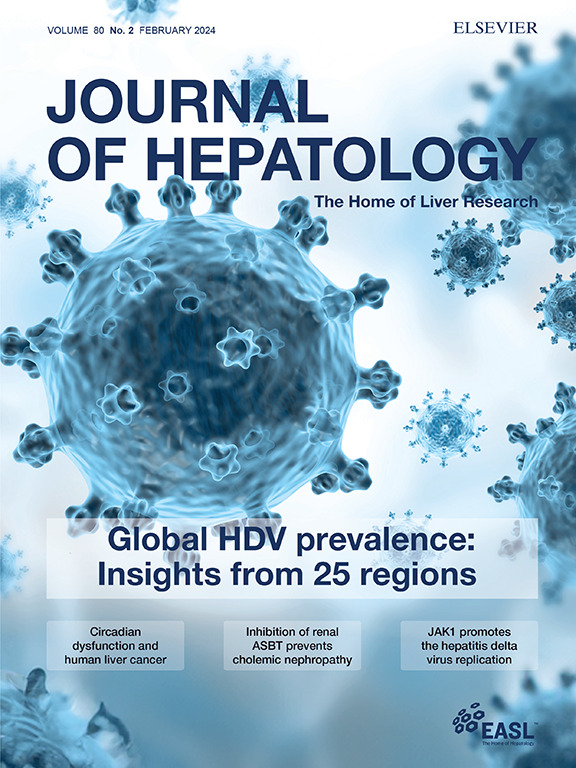New platinum derivatives selectively cause double-strand DNA breaks and death in naïve and cisplatin-resistant cholangiocarcinomas
IF 26.8
1区 医学
Q1 GASTROENTEROLOGY & HEPATOLOGY
引用次数: 0
Abstract
Background & Aims
Patients with cholangiocarcinoma (CCA) have poor prognosis. Current cisplatin-based first-line chemotherapy offers limited survival benefits. Cisplatin induces single-strand DNA breaks, activating DNA repair mechanisms that diminish its effectiveness. Here, we present the design, chemical synthesis, and therapeutic evaluation of a new generation of chemotherapeutic agents (Aurkines) with unique polyelectrophilic properties. These agents cause a high frequency of double-strand DNA breaks, bypassing DNA repair, and promoting cancer cell death.Methods
Two novel compounds, Aurkine 16 and Aurkine 18, were designed and evaluated for their antitumor effects in both naïve and cisplatin-resistant CCA cells, cancer-associated fibroblasts (CAFs), healthy cholangiocytes, and in vivo models.Results
Aurkines effectively induced double-strand DNA breaks, leading to increased DNA damage and elevated levels of reactive oxygen species, resulting in greater cytotoxicity than cisplatin in CCA cells. Phosphoproteomic and molecular analysis revealed that cisplatin activates DNA repair pathways, while Aurkines primarily induce apoptosis. Importantly, Aurkines also triggered apoptosis in cisplatin-resistant CCA cells and CAFs without harming healthy cholangiocytes. Additionally, Aurkines demonstrated cytotoxicity in other cisplatin-resistant cancers, such as breast and ovarian cancer. This tumor selectivity results from reduced uptake, increased efflux, and compact chromatin structure in normal cells, limiting Aurkine-DNA interactions. In vivo, Aurkines inhibited the growth of subcutaneous naïve and cisplatin-resistant CCA tumors, as well as orthotopic tumors in immunocompetent mice promoting antitumor immune cell recruitment, without any adverse events. Transport studies revealed that Aurkines were selectively taken up by OCT1, OCT3, CTR1, and OATP1A2, whereas only CTR1 transported cisplatin.Conclusions
Aurkines represent promising therapeutic drugs for both naïve and cisplatin-resistant cancers due to their unique polyelectrophilic properties and selective targeting of malignant cells.Impact and implications
This study introduces a novel therapeutic strategy designed to induce frequent double-strand DNA breaks selectively in both naïve and cisplatin-resistant cancer cells, without evident toxic side effects at therapeutic doses. This approach may settle the basis for new strategies to overcome the critical challenge of drug resistance in cancer treatment, and has the potential to be a breakthrough not only for the treatment of biliary tumors but also for other cancers.

新的铂衍生物选择性地导致naïve和顺铂耐药胆管癌双链DNA断裂和死亡
背景,目的胆管癌(CCA)患者预后差。目前以顺铂为基础的一线化疗提供有限的生存益处。顺铂诱导单链DNA断裂,激活DNA修复机制,从而降低其有效性。在这里,我们介绍了具有独特的多亲电性质的新一代化疗药物(Aurkines)的设计,化学合成和治疗评价。这些药物引起高频率的双链DNA断裂,绕过DNA修复,促进癌细胞死亡。方法设计两种新化合物Aurkine 16和Aurkine 18,并在naïve和顺铂耐药CCA细胞、癌症相关成纤维细胞(CAFs)、健康胆管细胞和体内模型中评估其抗肿瘤作用。结果索金有效诱导双链DNA断裂,导致DNA损伤加重和活性氧水平升高,导致CCA细胞的细胞毒性高于顺铂。磷酸化蛋白质组学和分子分析表明,顺铂激活DNA修复途径,而aurkinins主要诱导细胞凋亡。重要的是,Aurkines还能在不损害健康胆管细胞的情况下,触发顺铂耐药CCA细胞和caf的凋亡。此外,Aurkines在其他顺铂耐药癌症(如乳腺癌和卵巢癌)中显示出细胞毒性。这种肿瘤选择性是由于正常细胞摄取减少、外排增加和染色质结构致密,限制了aurkin - dna相互作用。在体内,Aurkines抑制皮下naïve和顺铂耐药CCA肿瘤的生长,以及免疫功能正常小鼠的原位肿瘤,促进抗肿瘤免疫细胞募集,无任何不良事件。转运研究显示,OCT1、OCT3、CTR1和OATP1A2选择性地摄取Aurkines,而只有CTR1转运顺铂。结论索尔金具有独特的多亲电特性和对恶性细胞的选择性靶向作用,是治疗naïve和顺铂耐药癌症的理想药物。影响和意义本研究介绍了一种新的治疗策略,旨在诱导naïve和顺铂耐药癌细胞选择性地频繁双链DNA断裂,在治疗剂量下没有明显的毒副作用。这种方法可能为克服癌症治疗中耐药性这一关键挑战的新策略奠定基础,并有可能成为胆道肿瘤治疗以及其他癌症治疗的突破。
本文章由计算机程序翻译,如有差异,请以英文原文为准。
求助全文
约1分钟内获得全文
求助全文
来源期刊

Journal of Hepatology
医学-胃肠肝病学
CiteScore
46.10
自引率
4.30%
发文量
2325
审稿时长
30 days
期刊介绍:
The Journal of Hepatology is the official publication of the European Association for the Study of the Liver (EASL). It is dedicated to presenting clinical and basic research in the field of hepatology through original papers, reviews, case reports, and letters to the Editor. The Journal is published in English and may consider supplements that pass an editorial review.
 求助内容:
求助内容: 应助结果提醒方式:
应助结果提醒方式:


